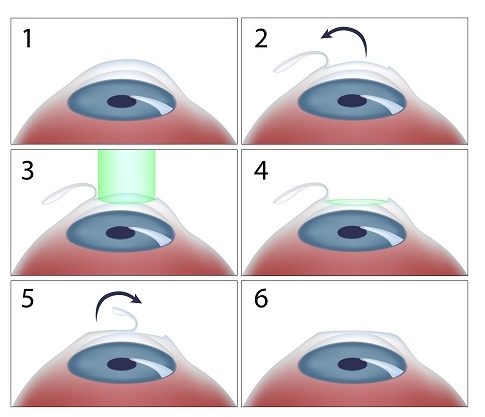There are three main parts to the human eye: the cornea, the lens, and the retina. In normal vision, the cornea refracts (bends) light so it can be directed correctly through the lens and onto the retina. Vision problems are usually the result of disorders or irregularities of the shape of the cornea. LASIK solves these problems by using lasers to reshape the curve of the cornea so you can have normal, clear vision.
About the Procedure
To begin the procedure, Dr. David O’Day creates a small flap to lift the outside layer of the cornea.
A vacuum ring is placed on the eye to keep the eyes from moving during the creating of the flap. During this process, vision is dimmed or even darken completely. After the flap is created vision returns to normal.
At this point, the flap is lifted, exposing the middle layer of the cornea which will receive treatment. This process takes only about 10-40 seconds to complete. While the right eye is being treated, the left eye will be patched, and vice versa. An eyelid holder or lid speculum is inserted around the eyelids to keep them from blinking.
Dr. O’Day will then ask you to stare at a red light in the laser machine. If for some reason you should look away from the red light, he will pause and instruct you to find the red light and continue with the LASIK procedure. Your LASIK procedure treatment is specifically designed based on measurements gathered at your pre-operative consultation.
Candidates for LASIK Surgery
- Must be at least 18 years of age.
- Vision prescription must be stable (not worsened) for at least one year
- Prescription for distance vision needs to match a certain minimal strength, and that prescription strength (glasses or contacts) must meet FDA approved guidelines for nearsightedness (Myopia) and farsightedness (Hyperopia).
- Pupils should NOT be larger than 8.5 mm in the dark due to increased risk of vision glare and halos at night and decreased night vision.
- Eyes should have a healthy retina, eye pressure and the cornea must have sufficient thickness.
- You should have no major eye diseases, no evidence of collagen, vascular, autoimmune diseases, along with no recent history of an ocular (eye) herpes, eye infection or inflammation, excessive corneal disease/scarring or severely dry eyes.
- You should NOT be a pregnant or a nursing mother
- You should have realistic vision expectations about LASIK eye surgery outcomes and must also be willing to accept the potential surgical risks, procedural complications and visual side effects of LASIK surgery.
- You should NOT have uncontrolled (unmanaged) diabetes, certain rheumatologic conditions (e.g., Lupus, Rheumatoid Arthritis, Sjorgens Disease).
How Long Does LASIK Take? Will It Hurt?
The actual LASIK procedure takes minutes per eye. You can expect to feel no pain at all, and perhaps just the slightest sensation of pressure. Inserting or removing contact lenses – or just rubbing tired eyes from wearing glasses produces more discomfort than a LASIK procedure.
Aftercare and Recovery
After the LASIK procedure, some patients report feeling mild discomfort in the form of irritated eyes, a foreign body sensation in the eye, or tearing/watering. Also, it is not unusual for your eyes to feel dry for the first several weeks after LASIK surgery, Dr. O’Day may recommend drops to help with this temporary dryness. Most LASIK patients notice dramatic results in vision within the first few days of their recovery; however, the speed of recovery often depends on personal healing patterns and the amount of your correction. Many patients feel comfortable after a short nap while wearing protective eye shields. For the first few days after LASIK, it is recommended that patients wear these plastic eye shields while sleeping to prevent any unconscious eye-rubbing. It’s important not to rub your eyes during the early healing stage.
Most patients return to work within a day or two after their LASIK procedure. Dr. David O’Day recommends the following restrictions following LASIK surgery:
- Wear sunglasses for at least one week
- Read in moderation for the first few days
- Do NOT wear eye makeup for one week
- Do NOT rub your eyes for one month
- Do NOT exercise for one week
- Avoid swimming, hot tubs and whirlpools for one week
- Avoid gardening and dusty environments for one week
- Avoid contact sports that could result in an eye injury for one month
- Smoking is allowed, but the smoke may irritate your eyes
What Is Blade-FREE LASIK?
The use of a laser instead of the microkeratome blade is what is meant by ‘bladeless’, ‘blade free’ or ‘all-laser’ LASIK. In the ‘bladeless’ technique, a laser forms a series of bubbles to create the flap. Depending on technical considerations for a particular set of eyes, a surgeon may or may not choose to use a laser for flap creation. Although the laser is a newer way of creating the flap, opinions vary on whether or not procedure outcomes are better or worse.
No matter what your vision-related issues, it is crucial to have a skilled, caring, and trusted health care provider. If you live in Mount Pleasant, North Charleston, and Myrtle Beach SC or surrounding areas, consider visiting Charleston Cornea & Refractive Surgery for a LASIK consultation to see if you are a candidate. Call us at (843) 856-5275 for more information.

